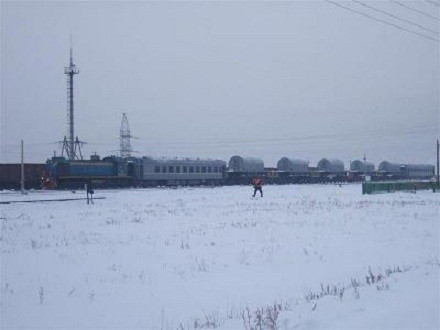Sandia Labs Helps Secure Nuclear Fuel in Kazakhstan

One of the ongoing problems with unclear non-proliferation efforts is what to do with nuclear material in the former Soviet Union. A group from Sandia National Laboratories recently completed a project in Kazakhstan, and took another step towards securing it.
A large cache of enriched nuclear fuel - some 13 metric tons -- was stored in a nuclear reactor in the port city of Aktau, on the Caspian seacoast. The reactor was a Soviet-era fast breeder reactor, designed to make nuclear fuel for both weapons and power plants. The reactor, which started operations in 1973, also provided 135 megawatts of electricity, 9 million gallons of water per day and steam for hot water and heating for Aktau. It was shut down by the Kazakh government in 1999.
David Barber, who worked on the project for Sandia Labs, said there was enough material for 775 nuclear weapons. The uranium and plutonium is also highly radioactive, so much so that handling it is dangerous.
That amount of nuclear material in a relatively unsecured area worried officials in the U.S. In 1996 the U.S., Russian and Kazakh governments embarked on a project to put it in a secure place.
Getting the material out of a seaport was one way to make it harder to steal, Barber said. So the U.S. and Kazakh governments embarked on a project to move it to a guarded - and remote - facility in the interior.
While the material is weapons-grade, that doesn't mean it can be used out of the box, Barber said. It would still have to be further processed to make a bomb. For reactor fuel, it would actually need to be made less pure than it is.
The nuclear fuel was placed in steel casks, each one the size of a train car. Each of the 60 casks weighs 100 tons. They are designed to hold the material for 50 years, and they were taken across Kazakhstan to a remote location (which is classified) in the northeastern part of the country.
The casks were put onto a special train, which made the 1,860 mile journey under guard. To make sure that nobody tried to sabotage the transport, nearly every mile of the tracks ahead were checked for damage. The casks are now stored in a guarded area outdoors, and rest on a giant slab of concrete.
Barber noted that Sandia specializes in physically protecting nuclear material. In this case, part of the system for protecting it is the containers being so large and moved so far from everything and everyone else. If someone were to try and get to the nuclear fuel, they would have to cut through steel and concrete, and have some way to handle it without exposing themselves to a lot of radiation. They would also have to get past the guards, a specially-trained group that protects nuclear fuel.
There were, he said, a number of firsts in this project. The shipment of uranium and plutonium, for example, was the largest outside the nuclear-armed states and perhaps the largest anywhere.
The last shipment of nuclear fuel was made in November. While the casks are certified to store the nuclear fuel for 50 years, between now and then the next phase of the project will get it moved to a permanent facility which can store it for the hundreds or thousands of years necessary.
The National Nuclear Security Administration (NNSA) oversaw the project as part of its Global Threat Reduction Initiative. In addition to Sandia, NNSA's team included staff from Idaho, Los Alamos, Oak Ridge and Pacific Northwest national laboratories, the U.S. Defense and State Departments, the Nuclear Regulatory Commission, the International Atomic Energy Agency, several contractors and the United Kingdom, Kazakhstan and Russia.
To contact the reporter responsible for this story call (646) 461 6917 or email j.emspak@ibtimes.com.
© Copyright IBTimes 2024. All rights reserved.





















